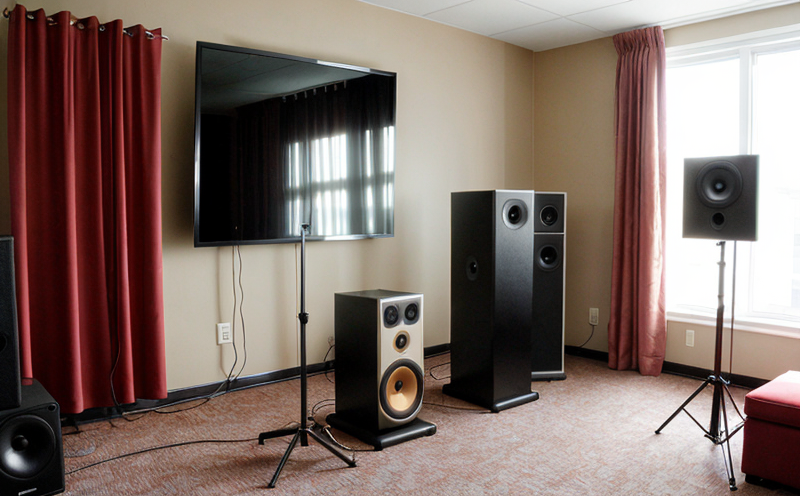ISO 16832 Sound Quality Metrics Testing (Fluctuation Strength)
The ISO 16832:2014 standard for sound quality metrics, including fluctuation strength testing, is designed to evaluate the subjective perception of sound quality by listeners. This service focuses on quantifying the perceived annoyance caused by fluctuations in sound intensity, which are common in environments like public spaces, transportation systems, and industrial settings.
Fluctuation strength measures the perceived change in loudness over time as experienced by human listeners. It is particularly important in assessing the quality of audio signals that undergo rapid changes in amplitude, such as speech or music recordings. The test involves generating a sound signal with controlled fluctuations in intensity and then playing it to a panel of listeners who rate their annoyance on a standardized scale.
The ISO 16832 methodology specifies the use of specific algorithms for calculating fluctuation strength metrics based on time-domain parameters like root mean square (RMS) values, peak-to-average power ratios, and perceived loudness levels. These calculations are designed to align with human auditory perception, ensuring that the test results accurately reflect how listeners perceive changes in sound intensity.
The service includes detailed preparation of audio signals according to ISO standards, calibration of test equipment, and selection of appropriate listening conditions such as room acoustics and listener demographics. Post-test analysis involves statistical evaluation of listener responses to determine fluctuation strength values.
A key aspect of this testing is the ability to compare different sound sources or modifications made by manufacturers in real-world applications. For instance, fluctuations can be reduced in audio equipment by optimizing filters or equalizers, resulting in more pleasant listening experiences for users. The service provides detailed reports that include fluctuation strength metrics alongside other relevant quality parameters.
The ISO 16832 standard is widely recognized and used across various sectors including automotive manufacturing, consumer electronics, telecommunications, and entertainment industries. Its application ensures compliance with international standards and enhances the overall user experience by minimizing unwanted auditory effects that can degrade sound quality perceptions.
Understanding fluctuation strength helps companies improve their products to meet specific market needs while ensuring they comply with relevant regulations. By leveraging this service, businesses can gain valuable insights into how their products perform under fluctuating conditions and make informed decisions about design improvements.
Scope and Methodology
The ISO 16832:2014 standard defines the procedure for measuring fluctuation strength in sound signals, which is a crucial parameter in assessing the perceived annoyance caused by rapid variations in loudness. This section outlines the detailed scope and methodology of our testing service.
- Test Setup: The test setup includes calibrated audio equipment capable of generating controlled fluctuations in intensity according to ISO 16832 specifications.
- Signal Generation: Audio signals are generated using standardized algorithms that simulate real-world conditions, ensuring accurate measurement of fluctuation strength.
- Listener Panel: A panel of trained listeners evaluates the perceived annoyance levels in response to the generated signals. The panel members rate their discomfort on a predefined scale.
The testing process begins with signal preparation, where audio files are processed using ISO 16832-compliant algorithms to introduce controlled fluctuations into the sound waveforms. Calibration of measurement equipment is performed before each test run to ensure accuracy and consistency across multiple tests.
During the actual testing phase, listeners evaluate the generated signals in a controlled environment designed to minimize external noise interference. Statistical analysis of listener responses provides fluctuation strength metrics that reflect both individual and average perceptions of annoyance.
Post-test evaluation involves reviewing all data collected during the test runs to identify trends and patterns in listener ratings. This comprehensive approach ensures reliable measurement of fluctuation strength, making it a valuable tool for product development and quality assurance processes within various industries.
Benefits
The ISO 16832 Sound Quality Metrics Testing (Fluctuation Strength) service offers numerous benefits to organizations seeking to enhance the auditory experience of their products and services. By implementing this testing, companies can ensure compliance with international standards while improving user satisfaction through better sound quality.
- Enhanced User Experience: Products evaluated using ISO 16832 meet high-quality benchmarks recognized globally, leading to superior customer experiences and increased brand loyalty.
- Regulatory Compliance: Adherence to international standards guarantees that products comply with relevant regulations, reducing the risk of non-conformance issues.
- Data-Driven Decisions: Detailed reports generated from testing provide actionable insights into product performance under fluctuating conditions, aiding informed decision-making processes within R&D departments.
- Competitive Advantage: Superior sound quality enhances the competitive position of companies in markets where auditory perception plays a significant role, such as consumer electronics and automotive manufacturing.
The service supports continuous improvement initiatives by identifying areas for enhancement through rigorous testing protocols. This proactive approach ensures that products consistently meet or exceed expectations set by international standards like ISO 16832.
By investing in this service, businesses not only comply with regulatory requirements but also contribute to the overall advancement of sound quality metrics within their respective sectors. The comprehensive nature of our testing ensures that every aspect of fluctuation strength is thoroughly assessed, providing a robust foundation for product development and quality assurance efforts.





